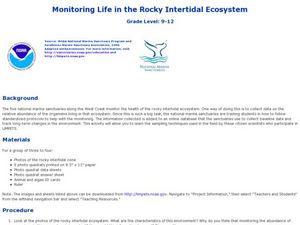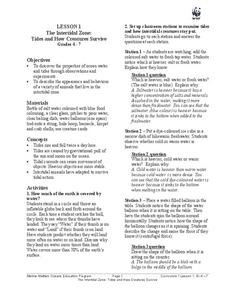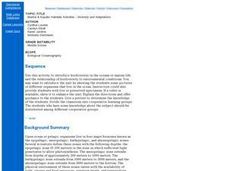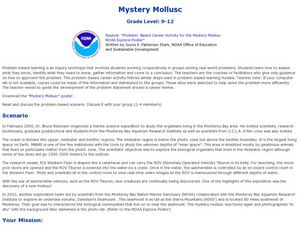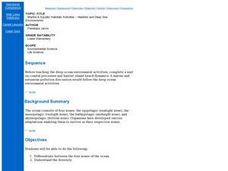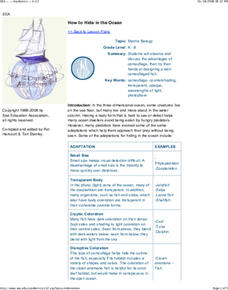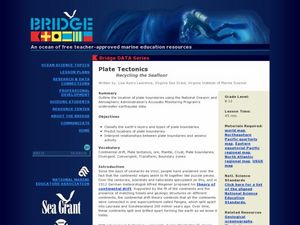NOAA
Marine Ecosystems
Be at the top of the food chain when it comes to understanding marine ecosystems. The 21st installment of a 23-part NOAA Enrichment in Marine sciences and Oceanography (NEMO) program investigates marine ecosystems, ocean zones, and food...
Curated OER
Turning the Tide on Trash: Marine Debris Curriculum
Seven pages of fascinating reading on marine debris preface the activities in this lesson plan. Four different activities are employed to simulate how the debris is distributed in the ocean and along beaches. Early ecology learners...
Curated OER
Ocean Life
Students explore the topics of ocean water salinity, ocean life zones, marine life classification, and ocean food chains. They observe demonstrations, conduct experiments, complete quizzes and handouts, and analyze key vocabulary.
Curated OER
The Magic School Bus Goes to Mussel Beach
Students investigate tides and create a model of an intertidal zone. In this hands-on marine science lesson plan based on a Magic School Bus book, the teacher leads students in a discussion about tides, then helps students model a tide...
Curated OER
Exploring Marine Ecosystems in the Caribbean and Maine
Students compare the marine habitats of Maine and the Caribbean using temperature, tides, ocean currents, latitude and longitude. In this marine ecosystems lesson, students analyze maps to complete graphic organizers that evaluate the...
Curated OER
The Intertidal Zone: Tide and How Creatures Survive
Students explore oceanography by completing science worksheets. In this tide pools instructional activity, students discuss the forces of the tide pools, the animals that live within them, and the impact they have on the rest of the...
Curated OER
Exploring the Beach
Students explore the beach. In this marine habitat lesson, students inspect sand grains, design beach profiles, classify marine life, and examine natural beach habitats. Students use spreadsheets to record data from their activities at a...
Curated OER
Marine Communities
Students view a video and then complete lab exercises to help them explain marine communities and animals in them.
Curated OER
Monitoring Life In The Rocky Intertidal Ecosystem
High schoolers investigate marine life by researching aquatic organisms on the Internet. In this oceanography lesson plan, students monitor algae and animals of the ocean by identifying their population and habitat on data sheet ID...
Curated OER
Plankton / Phytoplankton
Students discuss the importance of plankton in the ocean ecosystem. In this biology lesson, students identify the different types plankton by observing them under the microscope. They explain how plankton population affect global climate.
Curated OER
Salt Water Revival
Students produce a high tide. In this Marine Biology lesson, students visit a tide pool to investigate the creatures response to changes in the tide. Students discuss the results of their experimentation.
Curated OER
Ocean Habitats:
Students investigate the creatures of intertidal zones. They explore the adaptations species make to survive .
Curated OER
The Intertidal Zone: Tides and How Creatures Survive
Students study the properties of ocean water and tides and learn about animals that live in intertidal zones. In this intertidal zone lesson, students participate in classroom stations to learn about fresh water and salt water, cold...
Curated OER
Create an Underwater Scene
Pupils apply knowledge of underwater ocean life by creating an ocean life scene with marine animals and plants placed at appropriate ocean depths.
Alabama Learning Exchange
Action at Plate Boundaries
Students diagram the spreading of the ocean floor. In this earth science lesson plan, students read an article on plate boundaries of the ocean. Students are expected to diagram the oceanic convergent boundary, and...
Curated OER
Marine & Aquatic Habitats Activities - Diversity and Adaptations
Middle schoolers analyze biozones and how to identify and diagram them. They also research which organisms can adapt to different biozones.
Curated OER
Mystery Mollusc
High schoolers investigate the different regions of our oceans by researching the Internet. In this oceanography activity, students discover the different jobs related to ocean research and examine their roles by reading related...
Curated OER
Depth Line
Students use adding machine tape to plot increasing ocean depths and deep sea historical events.
Curated OER
Life In the Flood Zone
Students discover how floods occur by visiting the Weather Channel's website. They examine the areas of the United States which are more vulnerable for flooding. They research the history of previous floods and how to protect themselves.
Curated OER
Habitats and Deep Sea Environments
Students examine and identify the characteristics of the four zones of the ocean. They discover the amount of diversity in marine habitats. They also explore the adaptations organisms have that have allowed them to survive.
Curated OER
How to Hide in the Ocean
Learners observe the advantages of camouflage. They design a well camouflaged fish of their own.
Curated OER
Critter Characteristics
Learners explore the adaptations of deep sea life forms. In this science instructional activity, students watch a video to observe characteristics which allow for the sea creature to thrive in it's environment. Learners determine...
Curated OER
Under the Sea
Students identify and interpret that non-fiction books have features like a table of contents, a glossary, and an index, which can efficiently help them find information. They also identify how to narrow the search for information by...
Curated OER
Plate Tectonics: Recycling the Seafloor
Students classify earth's layers and plates using Ocean Seismicity data. In this plate tectonics lesson, students outline where the plate boundaries are on the world map. They then compare these predicted boundaries with USGS map of the...








